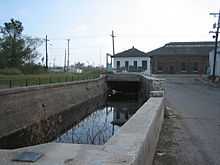Carondelet Canal
The Carondelet Canal, also known as the Old Basin Canal, was a canal in New Orleans, Louisiana, operating from 1794 into the 1920s. It was filled in 1938.


Construction of the canal began in June 1794 on the orders of Governor of Louisiana Francisco Luis Hector de Carondelet, for whom the canal was named. The 1.6‑mile long canal started at Bayou St. John, which connected with Lake Pontchartrain, and went inland to what was then the back edge of New Orleans, behind the French Quarter in the Treme neighborhood. The first shallow, narrow version of the canal was completed by the end of 1794. Over the next two years, further work made the canal wider and deeper. The canal served dual purposes of drainage for storm waters and shipping.
After the United States purchase of Louisiana, James Pitot worked to promote improvements of the canal. Starting in 1805, the Orleans Navigation Company improved the Canal and the Bayou, making it more important in shipping.
The 80,000-square-foot (7,400 m2) turning basin at the head of the Canal inspired the naming of Basin Street in New Orleans. Plans to build a connecting canal from the turning basin to the Mississippi River were never realized, in part because of the engineering challenges. Canal locks would have been needed due to the water level differences between the River and the Lake. Plans for that never-built canal influenced the name of Canal Street in the city. (The dream of a Lake-to-River canal was finally realized a century later with the construction of the Industrial Canal).
By the early 1820s, 70 to 80 vessels were reported using the Canal daily. In the early 19th century, the Francophone Creole section of the city was in competition with the Anglophone Uptown section; businessmen of the latter section constructed the competing New Basin Canal in the 1830s.
By the time of the American Civil War, the New Basin Canal was doing more than twice the business of the Carondolet, by then often referred to as the "Old Basin Canal". Larger ships too big to use the canal became more common in the late 19th century, but the Carondelet Canal was still economically important into the early decades of the 20th century. During this period it was important for the oyster boat business.
Early monarchs of the Zulu Social Aid & Pleasure Club Mardi Gras krewe made their entrance on the waters of the Old Basin Canal.
After World War I, use of the Canal declined further. In 1927 it was declared to no longer be a navigable waterway, and in 1938 the old canal was filled. Portions of the old Carondolet Canal infrastructure remain as among the oldest sections of the city's storm water drainage system.
See also
| Wikimedia Commons has media related to Carondelet Canal. |